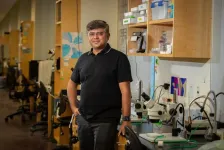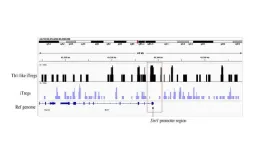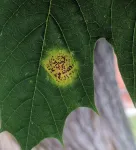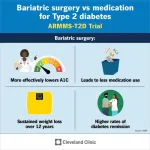(Press-News.org) (Santa Barbara, Calif.) — UC Santa Barbara researchers and collaborators in Colombia, Brazil and Germany are progressing toward an understanding of mechanisms that underlie Alzheimer’s disease, in particular an early-onset, genetic form that has afflicted generations of an extended family in Colombia. They also shed some light on a woman from that family who managed to beat the odds.
“What are the chances,” said UCSB neuroscientist Kenneth S. Kosik, a senior author of a paper that appears in the journal Neuron. “It’s unbelievable serendipity.”
It all takes place in the rural mountain communities on the outskirts of Medellín in the department of Antioquia, where Kosik has been collaborating with Colombian neuroscientist Francisco Lopera for decades to study the family, members of which, like clockwork, begin to present the signs of Alzheimer’s dementia in their mid-40s. Genetic testing revealed that they each carry a mutation, called the paisa mutation, in their PSEN1 gene. The mutation, labeled E280A, is linked to the accelerated development of the sticky plaques between neurons that would otherwise likely develop late in life. These plaques, in addition to tangles of a misfolded structural protein inside neurons called tau, are the hallmarks of Alzheimer’s disease.
What makes this family important, aside from their heroic willingness to work jointly with researchers, is that they are the largest known kindred in the world with autosomal dominant Alzheimer’s disease, meaning it only takes one parent with the mutation to pass it onward. There are other, smaller cohorts as near as a neighboring town and as far away as Japan and Italy, each with their own “private” mutations.
“You could think of Alzheimer’s as basically one of two types,” Kosik said. “It’s more complex than that, but to start, there are families in which it’s clearly genetic — if you get the mutation, you get the disease. And there’s all the other cases, which we call sporadic.” There may be risks that are passed down, and lifestyle and aging can play big roles in the sporadic cases, but there is no completely penetrant genetic link, he explained.
“So the question is, is there a difference that we can detect between cases which are strongly genetic, and cases in which other factors may be involved?” Kosik said. “If you alter your genes in two different ways, one with a mutation from the time of conception and the others from your small risk and lifestyle, are they the same set of genes or are they different sets?”
Turns out, there are differences. Using state-of-the-art technology called single nucleus sequencing, which allows researchers to see which genes are turned on at the individual cell level, project scientist and lead author Camila Almeida sequenced the genes of brain cells with genetic Alzheimer’s. This allowed the researchers to compare those sequences with that of a control group with no Alzheimer’s, and with that from a group with sporadic Alzheimer’s. Meanwhile, co-lead author Sarah Eger did the statistical heavy lifting that enabled the researchers to contextualize the data.
An incomplete destruction
“There is a difference in that if you have a mutation causing Alzheimer’s, you have a preferential activation in many different cell types — neurons, astrocytes and other cells — that turn on a autophagy system involved in taking proteins that are bad, that are misfolded, that may be contributing to disease, and destroying them,” Kosik said. This, he explained, means that the body is somehow alerted to these faulty proteins and has initiated a system of protein destruction, which is a normal, protective function of the body, though the compensatory response is ultimately unsuccessful.
“The mutation is making a protein that’s not normal, so the cell turns on these other genes to destroy the mutant protein, but it doesn’t quite work,” Kosik explained. In sporadic cases, the same system is turned on, but to a lesser degree. “There’s something else that’s probably more complicated happening there that we don’t fully understand,” he said.
These findings imply that since the genetic processes and patterns involved in the autosomal dominant cases are rather distinct from those involved in sporadic cases, treatments and therapies in development for the genetic version of Alzheimer’s may not be effective for the sporadic cases, and vice-versa. This is important, as clinical trials for potential Alzheimer’s drugs have been tested on populations such as the Colombia kindred. “I would say we have to be careful about extrapolating clinical trial results from the Colombian kindred because the disease mechanisms are a little different,” Kosik said.
A rare escapee
And then there’s Aliria Rosa Piedrahita de Villegas, a family member with the same mutation who defied the odds by living to her 70s without developing the dementia that cuts her relatives down before they reach 60. Much about how this remarkable woman managed to escape the disease despite having the PSEN1 E280A mutation is still a mystery, but thanks to her family’s donation of her brain to science, Kosik and his team are among several collaborations around the world uncovering clues as to how she accomplished that feat.
One clue that appeared when researchers examined her brain tissue: While Aliria had the same overproduction of senile plaques that the rest of her family had, the tangles of misfolded tau protein that typically accompany the plaques in the frontotemporal cortex of Alzheimer’s patients in her were relatively scant, keeping intact things like motor skills and executive function.
“She decoupled the two pathologies, and by having the plaques but not the tangles, she was spared dementia,” Kosik said. “It really pointed us to the fact that we better study the tangles; people can tolerate a lot of amyloid plaques the way she did, but once you get tangles, you’re in big trouble.”
Another promising line of inquiry lies in a second, equally rare mutation found in her cells called the Christchurch variant, named for the city in New Zealand where it was originally found. It’s a mutation to a gene that produces lipoproteins, called APOE (apolipoprotein E), which itself produces a protein that carries fats and cholesterol through the bloodstream.
“She had one gene that was turned on that no one else had in the rest of the people with the mutations, or even in the sporadic population,” Kosik said. They were shocked when they saw it.
“This gene is called LRP1,” Kosik said, adding that they were “puzzled and amazed” when they saw it because in the world of Alzheimer’s disease, LRP1 would more likely be a villain, encoding a receptor of the same name on the surface of the cells that binds to APOE but also takes up tau into cells. Previous research by the Kosik group revealed that suppressing LRP1 in mice models also reduced the chances that pathological tau would be taken up by neurons which would have then replicated the misfolded proteins and continued the process of neurodegeneration.
“But it was our thinking that was wrong, and not nature,” Kosik said. “Because it turns out that LRP1 was not increased in every cell type.” Indeed, they found an increase only in the astrocytes, star-shaped cells with neuroprotective functions. “What they probably do is destroy the tau,” Kosik explained. “So our hypothesis now is that the reason she was protected is because thanks to LRP1, her astrocytes could take up more tau and destroy it, and prevent it from spreading.”
The Kosik Lab is now working on proving this hypothesis.
END
Researchers make precious headway into a genetic form of Alzheimer’s disease
2024-02-27
ELSE PRESS RELEASES FROM THIS DATE:
CBD shown to ease anxiety without the risks that can come with THC
2024-02-27
Cannabis products high in the nonintoxicating compound CBD can quell anxiety better than THC-dominant products— and without the potential side effects, new University of Colorado Boulder research suggests.
The study of 300 people, published in the journal Cannabis and Cannabinoid Research, is the first randomized trial to examine how legal, commercially available cannabis impacts anxiety symptoms.
The study comes as one in five U.S. adults suffer from an anxiety disorder, making it the most common mental illness in the country, and prescriptions for anti-anxiety medications are on the rise.
“We ...
Sniffing our way to better health
2024-02-27
RIVERSIDE, Calif. -- Imagine if we could inhale scents that delay the onset of cancer, inflammation, or neurodegenerative disease. Researchers at the University of California, Riverside, are poised to bring this futuristic technology closer to reality.
In lab experiments, a team led by Anandasankar Ray, a professor of molecular, cell and systems biology, exposed the fruit fly (Drosophila melanogaster) to diacetyl, a microbial volatile compound released by yeast, and found changes in gene expression in the fly’s antennae in just a few days. In separate experiments, ...
Texas Tech and TTUHSC professors honored as NAI senior members
2024-02-27
The National Academy of Inventors (NAI) has announced four faculty members from the Texas Tech University System as part of the 2024 class of Senior Members.
Noureddine Abidi and Seshadri Ramkumar, both professors at Texas Tech University; Annelise Nguyen, associate dean for research at the School of Veterinary Medicine in Amarillo; and Hongjun (Henry) Liang, a professor from Texas Tech University Health Sciences Center (TTUHSC), join 120 other emerging academic inventors in this year’s class.
“These individuals are great representatives of the innovative spirit here at Texas Tech and are highly deserving of this recognition,” ...
UMass Amherst researchers identify enzyme key to training cells to fight autoimmune disorders
2024-02-27
Februay 27, 2024
UMass Amherst Researchers ID Enzyme Key to Training Cells to Fight Autoimmune Disorders
Discovery of new signaling pathway in immune cells may lay the foundation for drug-free, side-effect-free treatments for patients with aplastic anemia and other autoimmune disorders
AMHERST, Mass. – Researchers at the University of Massachusetts Amherst recently released a first-of-its-kind study that focuses on the rare autoimmune disorder aplastic anemia to understand how a subset of cells might be trained to correct the overzealous immune response that can lead to fatal autoimmune disorders. The research, published in Frontiers in Immunology, ...
Addressing societal concerns of genetic determinism of human behavior by linking environmental influences and genetic research
2024-02-27
It has long been known that there is a complex interplay between genetic factors and environmental influences in shaping behavior. Recently it has been found that genes governing behavior in the brain operate within flexible and contextually responsive regulatory networks. However, conventional genome-wide association studies (GWAS) often overlook this complexity, particularly in humans where controlling environmental variables poses challenges.
In a new perspective article publishing February 27th in the open-access journal PLOS Biology ...
Biodiversity appears to strongly suppress pathogens and pests in many plant and animal systems, but this “dilution effect” can vary strikingly in magnitude
2024-02-27
Biodiversity appears to strongly suppress pathogens and pests in many plant and animal systems, but this “dilution effect” can vary strikingly in magnitude
This study uses forest inventory data from over 25,000 plots to show that the prevalence of tree pests is jointly controlled by the diversity and phylogenetic composition of forests
#####
In your coverage, please use this URL to provide access to the freely available paper in PLOS Biology: http://journals.plos.org/plosbiology/article?id=10.1371/journal.pbio.3002473
Press-only preview: PENDING
Contact: Andrew Gougherty, andrew.gougherty@usda.gov
Image ...
Study shows bariatric surgery provides superior long-term treatment for type 2 diabetes in patients with obesity
2024-02-27
Tuesday, February 27, 2024, CLEVELAND: Research by Cleveland Clinic and three other U.S. medical centers has found that bariatric surgery provides better long-term control of blood glucose levels in patients with obesity and type 2 diabetes, compared with medical therapy.
Study participants who had bariatric surgery also experienced higher rates of complete diabetes remission up to 12 years after their surgical procedure.
The research was published in JAMA.
The Alliance of Randomized trials of Medicine vs Metabolic Surgery in Type 2 Diabetes (ARMMS-T2D) consortium analyzed long-term results of four randomized trials that were ...
Diet linked to preeclampsia among low-income Hispanic women during pregnancy
2024-02-27
A research study led by the Keck School of Medicine of USC found that certain combinations of foods consumed during pregnancy may be linked to a higher likelihood of developing preeclampsia, a potentially life-threatening blood pressure condition that can have serious consequences for both mother and baby.
The study, which focuses on low-income Hispanic women in Los Angeles, suggests that different combinations of foods in a woman's diet during pregnancy have the potential to increase or reduce the likelihood of preeclampsia development, and that interventions in diet during pregnancy may help reduce the risk of preeclampsia.
It is known that Hispanic women develop ...
Exposure to secondhand smoke during chemotherapy makes treatment less effective, study shows
2024-02-27
People who are diagnosed with head and neck cancer often receive a standard type of chemotherapy as part of their treatment. If they are exposed to secondhand smoke during chemotherapy — even if they have never smoked themselves — the treatment may be far less effective at killing cancer cells. That finding, considered the first of its kind, was revealed in a study recently published by researchers at the University of Oklahoma Health Sciences.
Tobacco use is a well-established risk factor for cancer and a signal of poor outcomes, especially ...
Polar climates changing in fundamental ways
2024-02-27
[Boston, MA—February 27, 2024] Research recently published early online in journals of the American Meteorological Society demonstrates changes at the Earth’s poles, including altered ocean-sea ice dynamics, dampened temperature extremes, and differing responses to solar radiation at the north and south poles, and suggests that long-term warming trends may have played more of a role in 2023’s record-low Southern Ocean ice than previously supposed.
Three papers in the Journal of Climate (JCli) find that the Arctic and Antarctic appear to be adjusting to a warming climate with fundamental changes in regional climate dynamics.
The Antarctic ocean-sea ice system may be fundamentally ...






